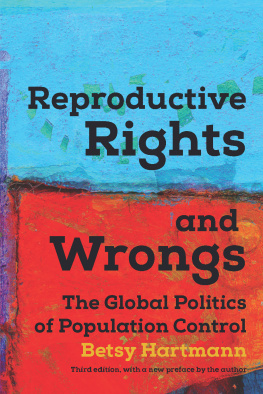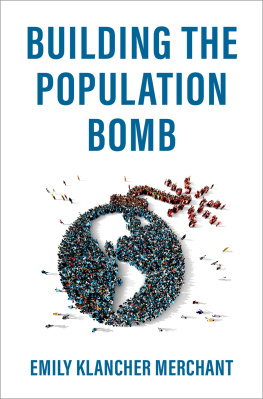PREFACE TO THE THIRD EDITION
Overpopulation: A Never-Ending Story
M ore than two decades have passed since the second edition of Reproductive Rights and Wrongs was published, but the book remains very relevant to the present political moment. While the term population control is out of favor, the practice hasnt died. The belief that overpopulation is a root cause of poverty, environmental degradation, resource scarcity, migration, violent conflict, and even climate change is pervasive. It influences popular media, environmental education and advocacy, and population, health, development, and security policies at home and abroad. Despite being cloaked in the language of womens empowerment, population control continues to have a negative impact on womens health, contraceptive choice, and human rights.
While this book is an important gateway into the population controversy, it is also part of a larger body of critical work that is continually growing as new scholars, writers, and activists take up the task of challenging population control from social, environmental, and gender justice perspectives. I am grateful to the many inspiring people I have met, collaborated with, and learned from in the years since the books publication . When you challenge a powerful conventional wisdom like overpopulation, it can feel at times like youre knocking your head against a brick wall. Its much more effective to put multiple heads, hands, and hearts together to make change, to dismantle the wall together, brick by brick.
Overpopulation is a particularly stubborn article of faith. It persists despite changing demographic realities. The era of rapid population growthoften dubbed the population explosionis over. Most countries have undergone a demographic transition to smaller families. Better living standards, improved access to education, health care, and social security, declines in infant and child mortality, rising costs of raising children, and improvements in womens status, including employment opportunities outside the home, all have encouraged smaller family size. So has urbanization. Now, more than half the worlds population lives in towns or cities, and this proportion is rising.
When I lived in a Bangladeshi village forty years ago, an experience that inspired this book, the average number of children per family was seven. Today, that figure has plummeted to around two. Average global family size is about 2.5 children, though regional differences remain. Birth rates are still relatively high in sub-Saharan Africa where in nineteen countries women have five or more children. But in that region, too, birth rates are declining, especially in urban areas. A number of countries in East Asia and Europe have birth rates below the replacement level of roughly two children per woman and are concerned about this negative population growth. The UN projects that the current world population of 7.3 billion will reach 9.7 billion in 2050 and 11.2 billion in 2100 before it levels off. However, the 11.2 billion projection may be too high and world population could peak at 9.5 billion instead.
The main reason we will add two to four billion more people to the worlds population before it stabilizes is not because women are having too many children. Rather, its because such a large proportion of the population in developing countries is young and approaching childbearing age. Over time, this baby boom will peter out as the present large generation of young people gets older and birth rates continue to decline. Many demographers now worry about how shrinking numbers of young people will support growing numbers of the elderly. The challenge that lies ahead is how to plan for these demographic dynamics in socially equitable and environmentally sustainable ways.
Why, then, is overpopulation ideology still so entrenched? One reason is that many people are demographically illiterate. This isnt their fault. Population education is woefully inadequate in the United States. Many social studies, biology, and environmental studies textbooks are outdated and still teach students that population growth is exploding out of control. People just dont know that small families are the global norm.
Another important reason is that the myth of overpopulation is so politically useful to powerful interests. Elites deploy it to explain and legitimize inequality, essentially blaming the poor for causing their own poverty. Inequality is even worse now than when I wrote this book. The gap between rich and poor has become a yawning abyss, the bitter fruit of decades of neoliberal economic policies, financial corruption and speculation, and dispossession of peasants and small farmers. Overpopulation is a convenient smokescreen that obscures the voracious appetites and power grabs of the superrich. Globally, the bottom 50 percent of adults on the wealth scale now own less than 1 percent of the worlds total wealth, while the richest 10 percent own almost 90 percent. The top 1 percent alone owns 50 percent. These numbers reveal the real problem: too few people control too many resources.
Overpopulation ideology also obscures the root causes of environmental degradation, a theme explored in this book. Today, population and environmental groups like the Sierra Club, the Center for Biological Diversity, and the Worldwatch Institute claim that reducing population growth will magically mitigate climate change. The reasoning behind this view is flawed. Industrialized countries, with only 20 percent of the worlds population, are responsible for 80 percent of the accumulated carbon dioxide in the atmosphere. Overconsumption by the rich has far more to do with climate change than the population growth of the poor. The few countries in the world where birth rates remain relatively high, such as those in sub-Saharan Africa, have among the lowest carbon emissions per capita on the planet. Contraceptives will not solve the climate crisisonly concerted national and international action to take on the fossil fuel industry, reduce carbon emissions and overconsumption, and shift to renewable energies will do so.
Climate change is only one of the many ways poor people, especially poor people of color, get scapegoated for environmental problems.
Overpopulation ideology is also very useful to national security interests. In the wake of 9/11, population narratives have come to figure prominently in the US war on terror. The theory that a high proportion of young people in a population causes youth bulges of angry young men who are easy recruits for terrorism, especially of the Islamic variety, is a rationale for racial and ethnic profiling.
This book ends in 1994, the year of the pivotal UN conference on population and development in Cairo, Egypt, where the international womens health movement pushed hard for reform. Hopes were high that the Plan of Action agreed on there by the worlds governments would lead to a new era of population policies, and that coercive, target-driven population control programs would give way to a broader approach to reproductive health, based on womens empowerment and freedom to choose. I supported that goal, but predicted that achieving it would be difficult.
Dislodging population control from family planning and reproductive health programs has proved an uphill battle. Just two years after the Cairo conference, the Fujimori dictatorship in Peru launched a campaign that sterilized an estimated three hundred thousand indigenous women without their consent.
After the Cairo conference, feminist and LGBTQ (lesbian, gay, bisexual, transgender, and questioning) activists were able to wedge open policy spaces where they could push for a holistic sexual and reproductive health and rights (SRHR) agenda. Progress was made in providing young people with quality health care, sex education and birth control, preventing and treating sexually transmitted diseases, challenging sexual violence and homophobia, and making abortion safe, legal, and accessible. But the backlash has been, and continues to be, fierce.
Next page









